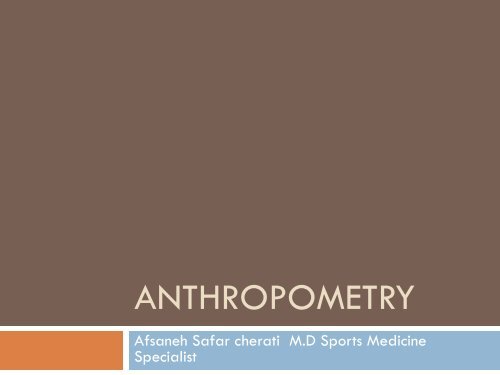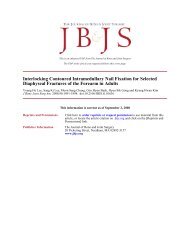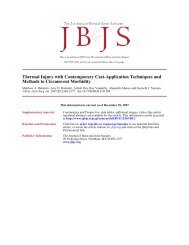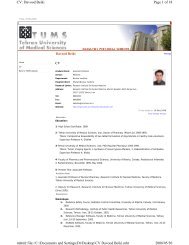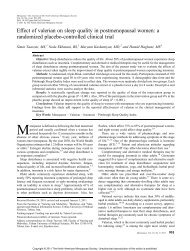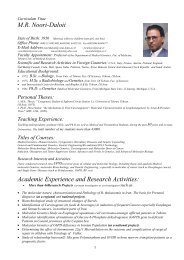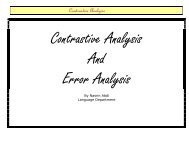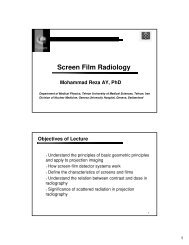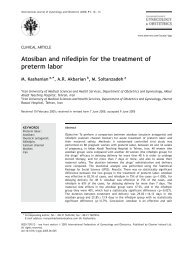ANTHROPOMETRY
ANTHROPOMETRY
ANTHROPOMETRY
You also want an ePaper? Increase the reach of your titles
YUMPU automatically turns print PDFs into web optimized ePapers that Google loves.
<strong>ANTHROPOMETRY</strong><br />
Afsaneh Safar cherati M.D Sports Medicine<br />
Specialist
What is Anthropometry?<br />
Greek<br />
Anthro- : man<br />
-pometry: measurements<br />
Literal meaning: “measurement of humans”<br />
The study of measurements or proportions of the<br />
human body according to sex, age, etc. for<br />
identification purposes & understanding human<br />
physical variation.
Kinanthropometry is an emerging scientific<br />
specialization concerned with the application of<br />
measurement to appraise human size, shape,<br />
proportion, composition, maturation and gross function.<br />
It is a basic discipline for problem-solving in matters<br />
related to growth, exercise, performance and nutrition.<br />
Anthropometry is the study of the measurement of the<br />
human body in terms of the dimensions of bone, muscle,<br />
and adipose (fat) tissue.
The area has been defined as the quantitative<br />
interface between anatomy and physiology. It puts<br />
the individual athlete into objective focus and<br />
provides a clear appraisal of his or her structural<br />
status at any given time, or, more importantly,<br />
provides for quantification of differential growth<br />
and training influences.
Today, anthropometry plays an important role in<br />
industrial design , clothing design, ergonomics and<br />
architecture where statistical data about the<br />
distribution of body dimensions in the population<br />
are used to optimize products.<br />
Changes in life styles, nutrition and ethnic<br />
composition of populations lead to changes in the<br />
distribution of body dimensions (e.g., the obesity<br />
epidemic), and require regular updating of<br />
anthropometric data collections.
History of Anthropometry<br />
1883- Alphonse<br />
Bertillon: system of<br />
identification<br />
depending on the<br />
unchanging character<br />
of certain<br />
measurements of parts<br />
of the human body<br />
”Bertillonage”- first<br />
adapted by the French<br />
police
History of Anthropometry<br />
1888: Francis Galton starts research on “Finger<br />
Prints” to further anthropometry<br />
Anthropometrics was first used in the 19th and early<br />
20th century in criminalistics, to identifying criminals<br />
by facial characteristics.<br />
Cesare Lombroso's criminal anthropology, he also<br />
believed that criminality could be predicted<br />
according to the body type.
Applications of Anthropometry<br />
Identification of repeat-offense criminals ( recidivists)<br />
Prevention of impersonation<br />
Differentiation between the races<br />
Advocacy of Eugenics policies in Europe<br />
Aryans from Jews: Nazi Germany famously relied<br />
on anthropometric measurements to distinguish<br />
Aryans from Jews on the basis of measurements<br />
of the skull and other physical features,<br />
“craniometric” certification, required by law.<br />
Intelligence tests became associated with<br />
Anthropometry
During the 1940s anthropometry was used by<br />
William Sheldon when evaluating his somatotypes,<br />
according to which characteristics of the body can<br />
be translated into characteristics of the mind.
National Aeronautics and Space<br />
Administration<br />
Anthropometry and biomechanics for designating points<br />
and distances of measurement, range, direction of<br />
motion, and mass for space module crewmembers and<br />
visiting personnel.<br />
For example : primary anthropometry effects of<br />
microgravity<br />
Height in Short-term mission : Slight increase during first week then stabilizes<br />
at approximately 3% of pre-mission baseline.<br />
Circumference changes in chest, waist, and limbs. Changes due primarily to<br />
fluids shifts.<br />
Post flight weight losses average 3.4%; about 2/3 of the loss is due to water<br />
loss, the remainder due to loss of lean body mass and fat. Center of mass shifts<br />
headward approximately 3-4 cm…
Debate over Anthropometry<br />
General Problems with Anthropometry:<br />
Cost and error of the instruments used<br />
Education needed to be able to take the<br />
measurements<br />
Error in calculation and measurements<br />
slow
Different body type: different performance<br />
A basically anthropometric division of body types<br />
into the categories endomorphic, ectomorphic and<br />
mesomorphic derived from Sheldon's somatotype<br />
theories is today popular among people doing<br />
weight training.
Somatotype<br />
A somatotype is a classification of physique based<br />
on the concept of shape, disregarding size.<br />
The pre-eminent system of somatotype classification<br />
is the Heath-Carter somatotype.<br />
Relative dominance of Endomorphy (relative<br />
fatness), Mesomorphy (relative musculo-skeletal<br />
robustness) and Ectomorphy (relative linearity).<br />
Each component is identified in the sequence<br />
endomorphy-mesomorphy-ectomorphy
Heath-Carter method<br />
Worldwide accepted<br />
Rating range is 1-9<br />
Anthropometric or photographic study<br />
A rating form and a 3 figure rating<br />
Ratings of 2 to 2.5 are considered low, 3 to 5 are moderate,<br />
5.5 to 7 are high and 7.5 and above are very high
Endomorphy<br />
0.7182 + 0.1451*ΣSF - 0.00068*ΣSF2 + 0.0000014*ΣSF3<br />
[where (SF = sum of triceps, subscapular and supraspinale skinfolds<br />
multiplied by (170.18/height in cms)]<br />
Mesomorphy<br />
0.858*humerus breadth +0.601*femur breadth + 0.188* corrected arm<br />
girth + 0.161*corrected calf girth - height*0.131 + 4.5<br />
Ectomorphy<br />
One of three equations is used depending on the value of the calculated<br />
Height Weight Ratio<br />
(HWR) of the subject. [HWR is height/mass.333].<br />
- If HWR is greater than, or equal to 40.75 then ectomorphy =<br />
0.732*HWR - 28.58<br />
- If HWR is less than 40.75 and greater than 38.25 then ectomorphy =<br />
0.463*HWR - 17.63<br />
- If HWR is equal to or less than 38.25 then ectomorphy = 0.1
Somatochart<br />
Description of subjects relative to their<br />
position on the somatochart<br />
X=Ecto-Endo<br />
Y=2*Meso-(Endo+Ecto)
Mesomorphy component : male gymnast , weight<br />
lifter, wrestler<br />
Basketball male =2.0-4.5-3.5<br />
Basketball female=4.0-4.0-3.0
Methodology of anthropometrical<br />
Ostensibly,<br />
anthropometry is<br />
simple. In reality, it is<br />
not.<br />
Standard<br />
specifications of the<br />
International Society<br />
for the Advancement<br />
of Kinanthropometry<br />
(ISAK).<br />
assessment
Anthropometry Instruments<br />
Anthropometric tape.<br />
The tape of choice is<br />
Keuffel and Esser<br />
Whyteface steel tape<br />
Bone calipers:<br />
Adapted Mitutoyo<br />
bone calipers are<br />
recommended for<br />
humerus and femur<br />
widths.
Anthropometer. The<br />
recommended instrument<br />
is the Siber-Hegner<br />
GPM anthropometer of<br />
the Martin type<br />
Widespreading<br />
calipers. The large<br />
widespreading caliper<br />
(Siber-Hegner, GPM) is<br />
the classical instrument<br />
for the measurement of<br />
Anterior-Posterior chest<br />
depth
Skinfold calipers. The<br />
preferred instruments<br />
are the Harpenden<br />
caliper or the Slim<br />
Guide skinfold<br />
calipers.<br />
Stadiometer<br />
Medical Scale
Techniques<br />
Precision is a matter of how consistent a measurer is<br />
with him or herself (intra-observer reliability) or<br />
with other measurers (inter-observer reliability).<br />
Accuracy is a matter of how closely obtained<br />
measures conform to true or ideal measures.<br />
Anthropometrists should verify their precision by<br />
calculating the Technical Error of Measurement(TEM)<br />
of their testing.<br />
The development of an anthropometrist’s touch is<br />
seldom achieved without extensive practice.
Marked Anatomic Landmarks<br />
Acromiale :The point at the<br />
superior and external border<br />
of the acromion process when<br />
the subject is standing erect<br />
with relaxed arms<br />
Radiale :The point at the<br />
upper and lateral border of<br />
the head of the radius<br />
Mid-acromiale-radiale. Arm<br />
girth, triceps and biceps<br />
skinfold sites. A line is marked<br />
horizontal to the long axis of<br />
the humerus at the midacromiale-radiale<br />
distance.
Iliocristale :The most lateral point superior of the<br />
iliac tubercle on the ilio-axilla line.<br />
Iliospinale :The inferior aspect of the tip of the<br />
anterior superior iliac spine.<br />
Supraspinale :A cross marking the intersection of<br />
the iliospinale mark to the anterior axillary border<br />
with the horizontal line of the superior border of the<br />
ilium at the level of the iliocristale
Subscapulare :The undermost tip of the inferior<br />
angle of the scapula.<br />
Mid thigh: The mid point between the inguinal fold<br />
and the anterior aspect of the patella.<br />
Abdominal: The site 5cm to the right hand side of<br />
the omphalion<br />
Mid-calf :The medial aspect of the calf at the<br />
widest girth
Proforma<br />
A standard proforma facilitates systematic data<br />
collection<br />
Only right side values of the subject are taken in<br />
surveys.<br />
When there is a question of bilateral asymmetry,<br />
both sides should be taken.<br />
The two standard ISAK proformas are the full<br />
Proforma which contains 42 measurement variables,<br />
and the shortened Level 1 Proforma which is used<br />
for training and assessing Level 1anthropometrists
Skinfold Thickness<br />
Harpenden skinfold caliper is designed to provide a<br />
constant pressure of 10.0 g/mm2 of the caliper face at<br />
all thicknesses.<br />
The skinfold is raised by the pinching, slightly rolling<br />
action of the left thumb and index finger. The fold is<br />
raised perpendicularly to the surface of the body at<br />
the measurement site. The long axis of the fold should<br />
be parallel to the natural cleavage lines of the skin<br />
(Langer’s lines) in the region of measurement.<br />
The reading is made approximately two seconds after<br />
application, when the needle slows.
Triceps. The caliper is<br />
applied 1 cm distally<br />
from the left thumb<br />
and index finger<br />
raising a vertical fold<br />
at the marked midacromiale-radiale<br />
line<br />
on the posterior<br />
surface of the right<br />
arm
Subscapular: The<br />
caliper is applied 1 cm<br />
distally from the left<br />
thumb and index finger,<br />
raising a fold oblique to<br />
the inferior angle of the<br />
scapula in a direction<br />
running obliquely<br />
downwards in a lateral<br />
direction at an angle of<br />
about 45° from the<br />
horizontal along the<br />
natural fold (Langerline)
Biceps. The caliper is<br />
applied 1cm distally<br />
from the left thumb<br />
and index finger<br />
raising a vertical fold<br />
at the marked midacromiale-radiale<br />
line<br />
on the anterior surface<br />
of the right arm
Iliac crest: The caliper<br />
is applied 1cm<br />
anteriorly from the left<br />
thumb and index<br />
finger raising a fold<br />
immediately superior<br />
to the iliac crest at the<br />
mid-axillary line (i.e.<br />
above the crest on the<br />
mid-line of the body)
Supraspinale: The<br />
caliper is applied 1cm<br />
anteriorly from the left<br />
thumb and index finger<br />
raising a fold at the<br />
intersection of the<br />
border of the ilium<br />
(project a horizontal line<br />
from the iliac crest mark)<br />
and a line from the<br />
spinale to the anterior<br />
axillary border (armpit).
Abdominal: The<br />
caliper is applied 1 cm<br />
inferiorly to the left<br />
thumb and index<br />
finger, raising a<br />
vertical fold on the<br />
right side 5 cm lateral<br />
to, and at the level of,<br />
the omphalion
Front thigh: The caliper is<br />
applied 1 cm distally to<br />
the left thumb and index<br />
finger, raising the fold on<br />
the anterior of the right<br />
thigh, when the leg is<br />
flexed to a 90° at the<br />
knee by placing the foot<br />
on a box. The mid-thigh<br />
position for this measure is<br />
the estimated halfdistance<br />
between the<br />
inguinal crease and<br />
anterior patella.
Medial calf. The caliper is<br />
applied 1cm distally to<br />
the left thumb and index<br />
finger, raising a vertical<br />
fold on the relaxed<br />
medial right calf at the<br />
estimated level of the<br />
greatest circumference.<br />
This is easiest to obtain<br />
when the subject’s leg is<br />
flexed to an angle of 90°<br />
at the knee by placing the<br />
foot on a box
Girths<br />
Instruments: Flexible steel tape, calibrated in<br />
centimeters with millimeter gradations.<br />
General technique: The metal case is held in the<br />
right hand throughout all the girth measurements.<br />
The girths are measured with the tape at right<br />
angles to the long axis of a bone or body segment.
Arm girth relaxed: The<br />
perimeter distance of<br />
the right arm parallel to<br />
the long axis of the<br />
humerus when the<br />
subject is standing erect<br />
and the relaxed arm is<br />
hanging by the sides.<br />
The level of the tape is<br />
at the measured and<br />
marked mid-acromialeradiale<br />
distance
Arm girth flexed and<br />
tensed: The maximum<br />
circumference of the<br />
right arm raised to the<br />
horizontal position in the<br />
sagittal plane with the<br />
fully-supinated forearm<br />
flexed at the elbow to<br />
an angle of 45°-90° .<br />
The anthropometrist<br />
standing laterally to the<br />
right of the subject
Waist girth: The<br />
perimeter at the level of<br />
the noticeable waist<br />
narrowing located<br />
approximately half way<br />
between the costal<br />
border and the iliac<br />
crest. Ask the subject<br />
some questions to ensure<br />
they do not hold their<br />
breath.
Gluteal girth (hip<br />
girth): The perimeter at<br />
the level of the greatest<br />
posterior protuberance<br />
and at approximately<br />
the symphysion pubis<br />
level anteriorly. The<br />
subject, during this<br />
measure, stands erect,<br />
feet together, without<br />
volitionally contracting<br />
the gluteal muscles
Calf girth: With the<br />
subject stands erect,<br />
legs slightly parted,<br />
weight equally<br />
distributed on both<br />
feet the tape is<br />
maneuvered to obtain<br />
the maximum<br />
perimeter of the calf.
Bone Breadths<br />
Instrument: Small Mitutoyo adapted bone caliper.<br />
General technique: The bone calipers are held in<br />
pistol-grip mode. The branches are gripped by the<br />
thumb and the index finger and rest on the backs of<br />
the hands. The middle finger is used to locate the<br />
landmark. Firm pressure is applied to the branches.
Humerus breadth (biepicondylar):<br />
The<br />
distance between medial<br />
and lateral epicondyles of<br />
the humerus when the arm<br />
is raised forward to the<br />
horizontal and the<br />
forearm is flexed to a<br />
right angle at the elbow.<br />
The measured distance is<br />
somewhat oblique since<br />
the medial epicondyle is<br />
lower than the lateral.
Femur breadth (biepicondylar):<br />
The<br />
distance between<br />
medial and lateral<br />
epicondyles of the<br />
femur when the subject<br />
is seated and the leg<br />
is flexed at the knee to<br />
form a right angle with<br />
the thigh.
Body mass (weight)<br />
body weight should be<br />
obtained on an<br />
accurately-calibrated<br />
beam-type balance and<br />
recorded to the nearest<br />
0.1 kg. As there are<br />
diurnal variations in<br />
weight, it is best to weigh<br />
the subject at the same<br />
time of day in each testing<br />
session. Recording the time<br />
of day at which<br />
measurements are made<br />
therefore necessary.
Stretch stature (height)<br />
The measurement is taken as<br />
the maximum vertical distance<br />
from the floor to the vertex of<br />
the head ,when the head is<br />
held in the Frankfort plane.<br />
This position is achieved when<br />
the line joining the orbitale to<br />
the tragion is horizontal or at<br />
right angles to the long axis<br />
of the body. The heels,<br />
buttocks, upper part of the<br />
back and usually, but not<br />
necessarily, the back of the<br />
head are in contact with the<br />
vertical wall.
Data Analysis<br />
Skinfolds:The most often-used data from<br />
anthropometric measurement is that obtained from<br />
skinfolds.<br />
Use the sum of varying numbers of skinfolds to<br />
calculate percentage body fat.<br />
The most useful application of skinfold data is the<br />
comparison over time of repeat measures on an<br />
individual to determine and quantify sub-cutaneous<br />
fat loss or gain.
Somatotype data can be statistically analyzed.<br />
Proportionality is the relationship of body parts, one to<br />
another or to the whole body.<br />
Middle distance runners tend to be long in the legs and<br />
arms, short in the trunk and narrow in the hips. “Long”,<br />
“short” and “narrow” are subjective evaluations based<br />
on some kind of metaphorical model of a human.<br />
A simple device for achieving this type of comparison is<br />
the unisex Phantom devised by Ross and Wilson and<br />
updated by Ross and Ward
Anthropometry Today<br />
Biometrics<br />
Nutrition and wellness<br />
Weight Training<br />
Ergonomics<br />
dynamic anthropometry: Measurements taken on and<br />
around the figure when it is in any position other than the<br />
fixed ones.<br />
Evolutionary Significance<br />
Changes in humans overtime<br />
Monitor growth in children<br />
Cranial Anthropometry
Biometrics<br />
Biometrics refers to methods for uniquely recognizing<br />
humans based upon one or more intrinsic physical or<br />
behavioral traits.<br />
Biometric characteristics can be divided in two main<br />
classes:<br />
Physiological are related to the shape of the body.<br />
Examples include, but are not limited to fingerprint,<br />
face recognition, DNA, hand and palm geometry, iris<br />
recognition,<br />
Behavioral are related to the behavior of a person.<br />
Examples include, but are not limited to typing rhythm,<br />
gait, and voice.
Biometrics<br />
the automatic identification of a person based<br />
on his/her physiological or behavioral<br />
characteristics<br />
Verification vs. identification<br />
Verification: Am I whom I claim I am? involves<br />
confirming or denying a person's claimed<br />
identity<br />
Identification: Who am I?
Biometrics Applications<br />
Forensics: criminal identification and prison<br />
security<br />
Prevention of unauthorized access to ATMs,<br />
cellular phones, smart cards, desktop PCs,<br />
workstations, and computer networks<br />
Automobiles: replace keys with key-less entry<br />
and key-less ignition<br />
Border control and national ID cards
Biometrics Programs<br />
Fingerprint Identification<br />
Hand Geometry: geometric shape of the hand for<br />
authenticating a user's identity<br />
Face Location: an arbitrary black and white, still<br />
image, find the location and size of every human<br />
face<br />
Multibiometrics: integrates face recognition,<br />
fingerprint verification, and speaker verification in<br />
making a personal identification
Biometrics in Use<br />
BenGurion Airport: Hand<br />
Geometry<br />
INSPASS: Hand<br />
Geometry<br />
FacePass: Face<br />
Verification<br />
Heathrow Airport- Iris<br />
Grocery Store Payment:<br />
Fingerprint
3- D Anthropometry<br />
Today people are performing anthropometry with threedimensional<br />
scanners. The subject has a three-dimensional<br />
scan taken of their body, and the anthropometrist extracts<br />
measurements from the scan rather than directly from the<br />
individual. Anthropometry can be greatly aided by the use of<br />
accurate digital humans.<br />
Programs:<br />
Cyberware<br />
DigiSize<br />
CySlice<br />
Ear Impression 3-D Scanner
Future Endeavors of Anthropometry?
Questions?<br />
Thank you for your time!


